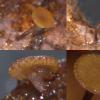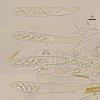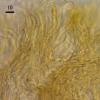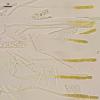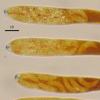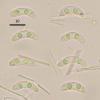
18-12-2025 21:17
Pol DebaenstThe identification took me to Byssonectria deformi

26-12-2025 21:19
Arnold BüschlenPithyella challaudii Pirou. Ist als Bryoparasit in

21-12-2025 09:32
Hello.A tiny ascomycete found embedded in wood in

24-12-2025 17:08
Hulda Caroline HolteHello, I have found this propoloid ascomycete on

21-12-2025 21:32
Pol DebaenstHello, Garden, Burgweg 19, Veurne, BelgiumOn 10/1
Rutstroemiaceae from cloudberry
Nina Filippova,
27-08-2013 13:31
this beautifil species was collected several times at leaves of Rubus chamaemorus. Could be from Rutstroemiaceae, but i have not succeeded in finding necessary description there. Four related species which could be found at this host: Sclerotinia tetraspora, Ciboria latipes, Scleromitrula rubicola, Rutstroemia chamaemori - all have different spores (no mention of allantoid shapes).
May be somebody is familiar with this?
Apothecia cupulate, stipitate, 1.3–4.7 mm in diameter, stem 0.8–2 mm high, site densely at both leaf sides, without sclerotia but black stromatized lines are present at the leaf; reddish-brown, hymenial surface minutely speckled, outer surface longitudinally rugose, stem base dark to dark brown.
Excipulum from porrecta, outer hyphae incrusted by brown pigment, at the edge not enlarged hyphoid elements; asci with crozies, euamyloid ring, 97.6–125 x 12.5–14; paraphyses cylindrical, enlarged to upper part, rarely branched, septated, with brown content in upper part, about 113 x 4.4 (width at upper part); spores allantoid, with two medium oils and several tiny, 17 (15.4–18.9) x 4.7 (4.1–5) (n=11).
Hans-Otto Baral,
27-08-2013 16:58

Re : Rutstroemiaceae from cloudberry
Hi Nina
indeed very interesting! I looked up the protologue of R. chamaemori and also see that your spores are longer and much more curved. My reproduction of the photos is not very good, maybe someone has a pdf with better quality? Perhaps Chris?
It is Holm & Holm 1977, Kew Bull. 31(3):567-572
In R. firma I noticed variation in spore curvature, maybe this is the reason also here. Were the spores always such in your finds? The spores on the photo of Pl. 25C in Holm look like having only small polar guttules, but I am not sure. the description says simply "guttulatae" which does not help.
Zotto
indeed very interesting! I looked up the protologue of R. chamaemori and also see that your spores are longer and much more curved. My reproduction of the photos is not very good, maybe someone has a pdf with better quality? Perhaps Chris?
It is Holm & Holm 1977, Kew Bull. 31(3):567-572
In R. firma I noticed variation in spore curvature, maybe this is the reason also here. Were the spores always such in your finds? The spores on the photo of Pl. 25C in Holm look like having only small polar guttules, but I am not sure. the description says simply "guttulatae" which does not help.
Zotto
Nina Filippova,
27-08-2013 17:53
Re : Rutstroemiaceae from cloudberry
Hello, Zotto,
there are raw pictures of the specimen,
https://www.cubby.com/pl/%234364/_3840835779bb44b195cf01598cd04670
I guess they all are done from one apos, but the specimen is not at hand now and i am not sure about spore shape variation (i will reply with this in three weeks when reach the collection).
In this examined apos all spores were that curved.
Nina.?
